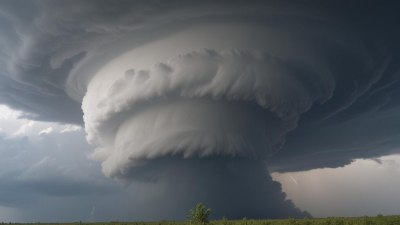Why Hurricanes Sometimes Spawn Dozens of Tornadoes Inside Them
Discover why hurricanes can generate multiple tornadoes and the science behind this surprising phenomenon.

This image was created with the assistance of Freepik
Hurricanes are among the most powerful and destructive forces of nature, capable of wreaking havoc along coastlines and beyond. While the main concern during a hurricane is typically the high winds, torrential rain, and storm surges, there is another danger that can emerge from these massive storms: tornadoes. It may come as a surprise to many, but hurricanes can produce dozens of tornadoes, leading to significant damage far from the eye of the storm. In this article, we'll explore the science behind why hurricanes can spawn tornadoes and the conditions that contribute to this phenomenon.
Understanding Hurricanes
To comprehend how tornadoes can form within hurricanes, it’s essential to understand what a hurricane is. A hurricane, also referred to as a tropical cyclone or typhoon in other parts of the world, is a large organized system of clouds and thunderstorms characterized by low-pressure areas, high winds, and heavy rainfall. Hurricanes develop over warm ocean waters and require specific atmospheric conditions to strengthen. The warm ocean surface heats the air above, initiating a cycle of upward air movement, creating a feedback loop that intensifies the storm.
The Anatomy of a Hurricane
Hurricanes consist of several key components: the eye, the eye wall, and the spiral bands. The eye is the calm center of the hurricane, surrounded by the eye wall, which features the strongest winds. Outside of the eye wall are the spiral rain bands, where rain and winds gradually decrease in intensity. These rain bands can extend for hundreds of miles from the center of the storm and can be highly unstable, providing conditions conducive to the formation of tornadoes.
Conditions Favoring Tornado Formation
For tornadoes to develop, several specific atmospheric conditions must be present, including wind shear, instability, and moisture. Wind shear refers to the change in wind speed and direction with altitude. In hurricanes, powerful winds associated with the storm can produce significant wind shear, especially as the hurricane interacts with surrounding atmospheric conditions. This shear can spin up mesocyclones—precursors to tornadoes—within the convective activity of the hurricane.
The Role of Vertical Wind Shear
As hurricanes churn through the ocean, they often encounter varying layers of atmospheric wind patterns. This can lead to significant vertical wind shear, which is the difference between the wind speeds and directions at different altitudes. In addition to creating turbulence, vertical wind shear can help organize thunderstorms and create rotating updrafts, which can easily develop into tornadoes. These updrafts allow the warm, moisture-laden air in the hurricane’s rain bands to rise rapidly, creating the perfect breeding ground for tornado formation.
Temperature Contrast and Instability
Hurricanes are typically surrounded by a significant temperature contrast between the warm, moist air in the storm and the cooler, drier air aloft. This contrast helps create instability in the atmosphere. Instability occurs when warm air rises quickly, which can lead to the formation of strong thunderstorms. Within these thunderstorms, conditions can become ideal for tornadoes to form as updrafts can rapidly rotate, creating the necessary rotation for tornadoes.
Colliding Weather Systems
Hurricanes don’t operate in isolation; they exist within a larger weather framework. When hurricanes encounter different weather systems, such as cold fronts or other disturbances, they can create even more significant instability and turbulent conditions. The interaction between these systems can lead to the generation of multiple tornadoes as the hurricane's powerful dynamics interact with surrounding weather phenomena.
Historical Context: Tornadoes from Hurricanes
Historically, there have been numerous instances where hurricanes have spawned tornadoes. For example, the 1999 tornado outbreak associated with Hurricane Floyd produced over 30 tornadoes across multiple states. Similarly, Hurricane Harvey in 2017 caused tornadoes in Texas as it made landfall and moved inland, showcasing that tornadoes formed from hurricanes are not just an occasional occurrence but a regular feature of these powerful storms.
Quantifying Tornado Production in Hurricanes
Research has shown that not every hurricane produces tornadoes, but when they do, the number can vary widely. On average, a hurricane can spawn anywhere from a handful to over 100 tornadoes during its lifecycle. These tornadoes can range in strength from weak EF0 tornadoes to powerful EF2 and EF3 tornadoes, causing considerable damage. The randomness of tornado formation means that predicting their occurrence within a hurricane remains a challenge for meteorologists.
Forecasting Tornadoes in Hurricanes
Forecasting tornadoes generated by hurricanes is a complex process that involves advanced meteorological models, radar technology, and observational data. Meteorologists rely on Doppler radar to detect rotating storms and identify favorable conditions for tornado development. However, the transient nature of hurricane-related tornadoes can make predictions difficult. Tornado watches and warnings are issued when conditions seem favorable, helping to ensure that the public remains alert and prepared for the possibility of tornadoes emerging from hurricanes.
Impact of Tornadoes from Hurricanes
The impact of tornadoes spawned by hurricanes can be devastating. While the overall destruction often associated with hurricanes comes from flooding, wind damage, and storm surges, tornadoes can cause localized destruction that can be just as severe. Structures can be flattened, trees uprooted, and lives altered in an instant. Tornadoes formed during hurricanes add a layer of complexity to disaster preparedness and response, making it essential for residents in hurricane-prone areas to stay informed and have robust emergency plans in place.
Mitigating the Risks
Given the potential for tornadoes to accompany hurricanes, it's crucial for communities to engage in proactive disaster preparedness. This includes understanding local weather patterns, listening to forecasts, developing a comprehensive emergency plan, and having supplies ready for such events. Education and awareness play a vital role in minimizing risk and maximizing safety during hurricane and tornado events.
In summary, hurricanes can spawn several tornadoes due to the unique atmospheric conditions they create. From wind shear and instability to interactions with other weather systems, the dynamics within hurricanes allow for the formation of tornadoes. Recognizing this phenomenon highlights the complexity and danger of hurricanes, emphasizing the need for continuous research and improved forecasting methodologies. As we continue to study and understand these storms, we can better prepare for the dual threats of hurricanes and tornadoes that can devastate communities.











